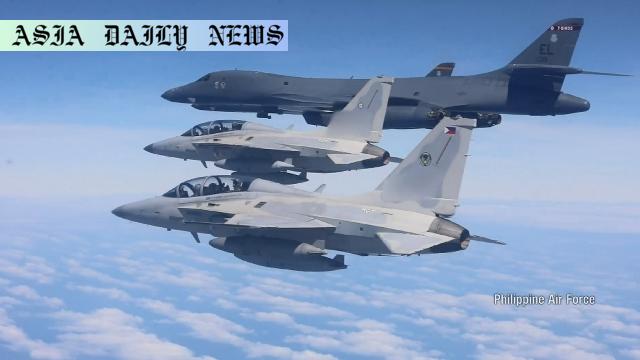South China Sea, US and Philippine air forces conduct joint patrols amid escalating territorial tensions with Beijing.
- South China Sea tension escalates as US and Philippines conduct joint air drills.
- Two US B-1 bombers participated in patrols over disputed Scarborough Shoal.
- Exercises underline security measures amid Manila’s territorial disputes with Beijing.

Introduction
The United States and the Philippines have continued to strengthen their strategic partnership in the Asia-Pacific region, conducting joint military exercises over the disputed South China Sea. This latest development highlights escalating tensions surrounding territorial claims in the region, notably between Manila and Beijing. On Tuesday, the two nations’ air forces carried out a series of patrol flights aimed at reinforcing security and showcasing their commitment to regional defense.
Scope of the Exercises
The air drills featured two U.S. B-1 bombers, widely recognized for their long-range and heavy payload capabilities. These formidable aircraft flew alongside Philippine air force planes during a one-day patrol that included a significant flyover of the Scarborough Shoal. This area, located in the contested South China Sea, is currently controlled by China despite claims by the Philippines of sovereignty over the territory.
Backdrop of Rising Tensions
The joint exercises occur against a backdrop of increasing maritime confrontations between the Philippines and China. Manila has repeatedly reported sightings of Chinese Coast Guard vessels venturing into its exclusive economic zone (EEZ). Most strikingly, some of these incursions have involved one of China’s largest ships—an intimidating vessel that Filipino officials now refer to as the “monster.” These actions, deemed aggressive by the Philippines, have fueled calls for greater support from allied nations such as the U.S.
Significance of the Drills
This display of military cooperation holds significant geopolitical implications. For the Philippines, engaging in these collaborative efforts with the United States signals a determination to defend its territorial claims. For the U.S., such exercises serve as a reaffirmation of its presence and influence in the Indo-Pacific, a region increasingly dominated by China’s growing military power. Scarborough Shoal’s strategic location makes it a focal point of this struggle, symbolizing larger disputes over international maritime boundaries.
Implications for Regional Security
Joint patrols by the Philippines and the U.S. send a message that allies in the region are prepared to challenge practices they perceive as infringements of sovereignty. However, these actions are likely to draw strong reactions from China, which considers almost the entirety of the South China Sea its territory. As such, these developments contribute to a broader narrative of rising tensions. Regional actors now face mounting pressures to navigate these disputes diplomatically while preparing strategic deterrents.
The Role of Multinational Alliances
These exercises also underline the importance of multinational partnerships in countering unilateral actions within contentious regions. Beyond the bilateral collaboration between the United States and the Philippines, the situation invites input from other affected nations, such as Vietnam and Malaysia. Multinational dialogues and agreements may serve to de-escalate conflicts while fostering cooperative approaches to shared security challenges in Southeast Asia.
Conclusion
The joint air patrols over the South China Sea mark a pivotal moment in addressing ongoing disputes in the region. As tensions persist, collaborations like these highlight the need for careful negotiation and concerted action. For the Philippines, aligning with global powers provides reassurance of support, while for the U.S., it solidifies its influence in the Pacific. Meanwhile, all parties must weigh the risks of military posturing against the imperative for regional stability.



Commentary
Geopolitical Ramifications
The ongoing joint drills in the South China Sea present a fascinating yet tense dynamic in international relations and regional security. America’s involvement reflects its commitment to allies and to maintaining the balance of power in a region that is becoming increasingly polarized by territorial and geopolitical disputes. For the Philippines, this partnership symbolizes resistance against China’s persistent assertiveness and infringement within its maritime zones.
The Risk of Escalation
While these exercises demonstrate unity and preparedness, they also amplify the risk of miscalculation. China’s reaction, which has historically been stern against such displays, could lead to further aggressive maneuvers. Sovereignty disputes, especially regarding critical locations like Scarborough Shoal, make this issue more precarious. Without open and transparent communication channels, incidents such as these could spiral out of control.
Looking Forward: Strategic Cooperation
What remains to be seen is how both governing bodies, particularly within ASEAN, manage these arising challenges. Strengthening multinational cooperation while continuously encouraging diplomatic dialogue may be the only sustainable path forward. However, this is no easy feat, especially given the entrenched geopolitical and economic interests in the region. The U.S.-Philippines exercises not only underscore mutual interests but also raise the stakes, urging broader international engagement.